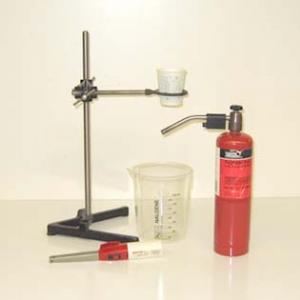College of Liberal Arts & Sciences
4B50.20 - Boiling Water in a Paper Cup
Fill the cup 3/4 of the way with water and place in the holder. Use the torch or Bunsen burner either on the bottom or the side of the cup. Note that all portions of the cup not touching water will burn off, but that the rest of the cup will be undamaged or only slightly scorched until the water starts to boil away.
An easier version of this is to wrap paper tightly around a metal rod and tape in place. When you put the paper covered rod into the flame the paper will not burn because the rod is conducting the heat away.
- Thomas B. Greenslade Jr., "Melting Metal on a Playing Card", TPT, Vol. 54, #4, Apr. 2016, p. 227.
- Charles Vivian, "A Paper Saucepan That Will Not Burn", Science Experiments & Amusements For Children, p. 56.
- Charles Vivian, "A Trick of Heat", Science Experiments & Amusements For Children, p. 17.
- Vicki Cobb and Kathy Darling, "A Cold Fact", Bet You Can't!, p. 92.
- Vicki Cobb and Kathy Darling, "Playing with Fire", Bet You Can!, p. 49.
- Vicki Cobb and Kathy Darling, "Fireproof Paper", Bet You Can!, p. 48.
- Janice VanCleave, "31. Paper That Won't Burn", Teaching the Fun of Physics, p. 48.
- Janice VanCleave, "29. Boil Water in a Paper Cup", Teaching the Fun of Physics, p. 46.
- Joey Green, "Paper Cup Boiler", The Mad Scientist Handbook 2, p. 71.
- Robert Ehrlich, "I.6. Burning Paper and Styrofoam Cups", Turning the World Inside Out and 174 Other Simple Physics Demonstrations, p. 118 - 119.
- Tik L. Liem, "The Exact Paper Circle", Invitations to Science Inquiry - Supplement to 1st and 2nd Ed. p. 42.
- Carl Ahlers, "Boiling Water in a Paper Pan", Expose Excite Ignite! An Essential Guide to Whizz-Bang Chemistry, p. 57.
- Borislaw Bilash II, “The Paper Kettle“, A Demo A Day – A Year of Physical Science Demonstrations, p. 72.
- Julius Sumner Miller, Q94 & A94, Millergrams I – Some Enchanting Questions for Enquiring Minds, p. 61 & 109.
Disclaimer: These demonstrations are provided only for illustrative use by persons affiliated with The University of Iowa and only under the direction of a trained instructor or physicist. The University of Iowa is not responsible for demonstrations performed by those using their own equipment or who choose to use this reference material for their own purpose. The demonstrations included here are within the public domain and can be found in materials contained in libraries, bookstores, and through electronic sources. Performing all or any portion of any of these demonstrations, with or without revisions not depicted here entails inherent risks. These risks include, without limitation, bodily injury (and possibly death), including risks to health that may be temporary or permanent and that may exacerbate a pre-existing medical condition; and property loss or damage. Anyone performing any part of these demonstrations, even with revisions, knowingly and voluntarily assumes all risks associated with them.

